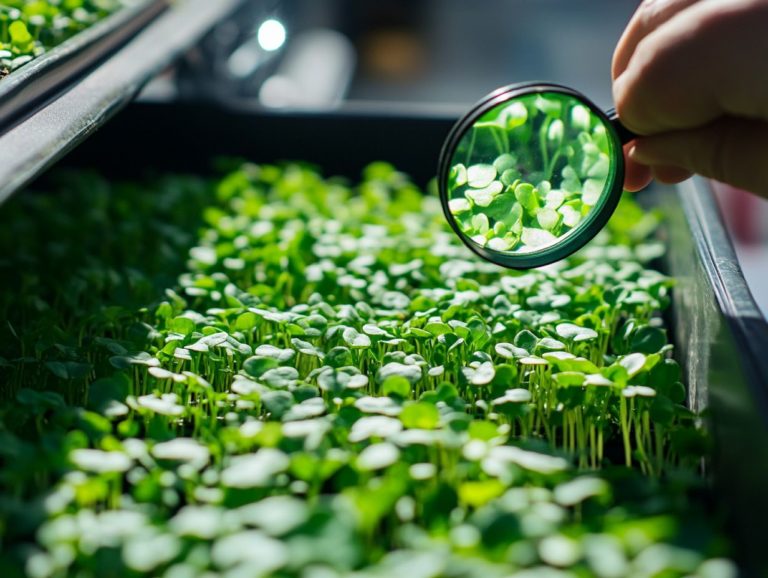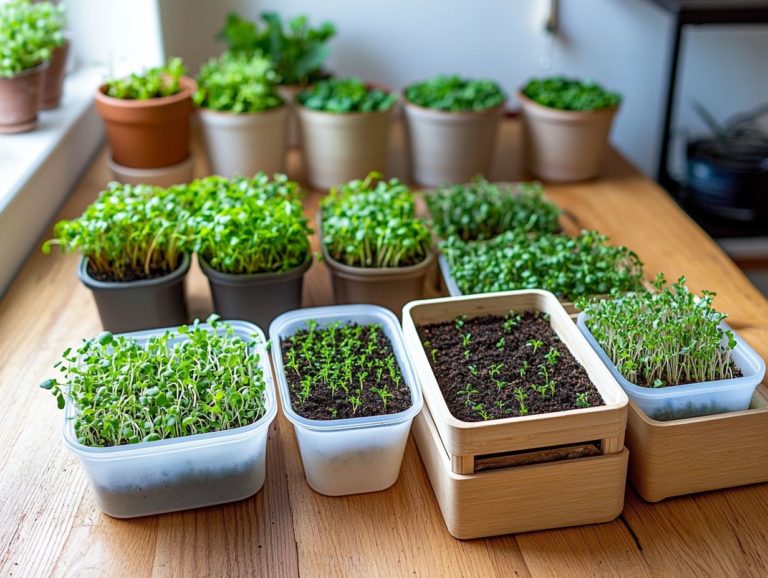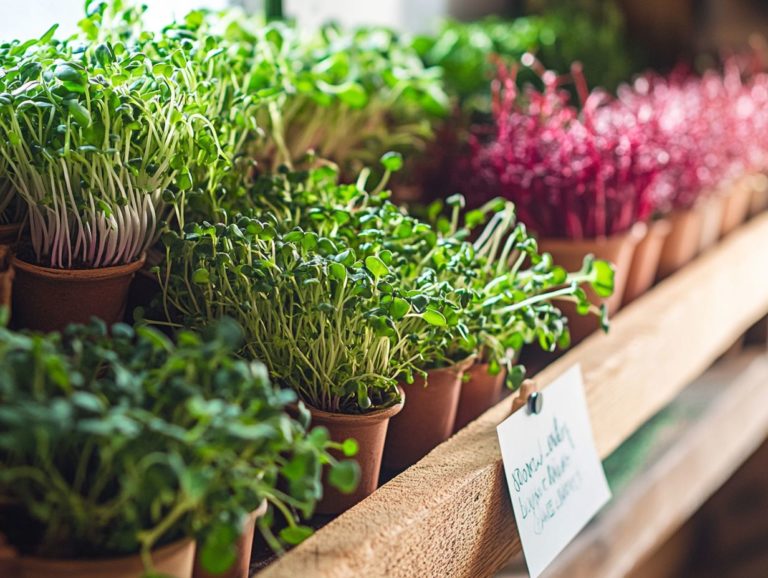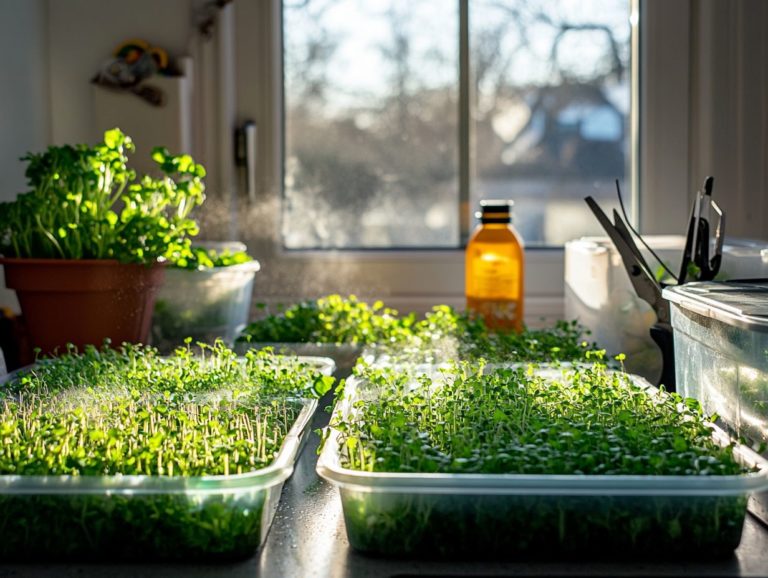The Best Time of Day to Harvest Microgreens
Microgreens are delightful little plants. They are brimming with nutrients and can elevate the flavor and presentation of any dish.
This article will explore what microgreens are and the various factors that influence their harvest time, such as growing conditions and the taste you’re aiming for. You’ll discover the best time of day to harvest for maximum nutrient content, along with effective techniques to ensure you’re making the most of them.
You will also learn how to store and use fresh microgreens to enhance your meals effortlessly.
Get ready to elevate your culinary skills with exciting new flavors!
Contents
- Key Takeaways:
- Understanding Microgreens
- Factors Affecting Microgreen Harvest Time
- Best Time of Day to Harvest Microgreens
- Harvesting Techniques for Microgreens
- Storing and Using Harvested Microgreens
- Frequently Asked Questions
- What is the best time of day to harvest microgreens?
- Can microgreens be harvested at any time of day?
- Why is it important to harvest microgreens at the right time of day?
- Are there certain factors to consider when determining the best time of day to harvest microgreens?
- Can microgreens be harvested in the evening?
- Do different types of microgreens have different optimal harvest times?
Key Takeaways:

- Harvest microgreens in the morning to ensure maximum nutrient content and freshness.
- Consider the desired flavor and texture when determining the best time to harvest microgreens.
- Proper harvesting techniques and tools are essential for preserving the quality of microgreens.
Understanding Microgreens
Understanding microgreens is crucial for anyone passionate about home gardening or urban farming. These petite vegetables offer an impressive nutritional boost. Microgreens are young, edible plants harvested shortly after germination, typically just after they develop their first true leaves, also known as the first leaves that appear after germination.
Varieties such as broccoli, sunflower, arugula, and basil stand out not only for their delightful flavors but also for their health benefits. By mastering the best growth stages, you can enrich your harvest and maximize their nutritional value, transforming them into a charming addition to salads and various dishes.
What are Microgreens?
Microgreens are young, tender plants you harvest just after their first true leaves. They deliver a delightful burst of flavor and nutrients in a petite package.
These little wonders go through distinct growth stages, starting with germination, where the seeds absorb moisture and swell. Next, the cotyledons emerge the first leaves you ll see. As these young plants mature, they develop true leaves, signaling that they re ready for your kitchen.
Popular varieties like broccoli and sunflower microgreens are not just known for their vibrant flavors; they re also packed with health benefits. Broccoli microgreens, for instance, are rich in antioxidants, perfect for enhancing your salads. Meanwhile, sunflower microgreens add a delightful nutty crunch to your dishes, making them versatile companions in a wide array of culinary creations.
Factors Affecting Microgreen Harvest Time
Several factors play a crucial role in determining the optimal harvest time for microgreens, including growing conditions, density, and the specific flavor and texture you desire from your crops. Understanding these influences enables you to pinpoint the ideal moment for harvest, maximizing both flavor and nutritional value.
For example, different microgreen varieties, like arugula and basil, can be harvested at varying growth stages to achieve the best taste and health benefits. By being mindful of these elements, you can truly optimize your microgreen production, whether you’re a home gardener or an urban farmer.
Growing Conditions and Varieties
Growing conditions are vital for your success in cultivating microgreens, whether you’re opting for soil, compost, or hydroponic methods.
Understanding these conditions can elevate both your yield and flavor. For example, the quality of your soil is critical. A well-aerated mix rich in organic matter promotes robust root development. By incorporating compost, you enhance nutrient availability and nurture beneficial microbial activity that supports healthy plant growth. Hydroponic techniques provide a soilless alternative that can lead to faster growth rates and more concentrated flavors.
No matter which method you choose, achieving the right nutrient balance is essential. It directly influences the taste and health benefits of your microgreens, ensuring they deliver maximum flavor and nutrition for any culinary endeavor.
Start your microgreen journey today and enjoy fresh flavors right from your own home!
Desired Flavor and Texture
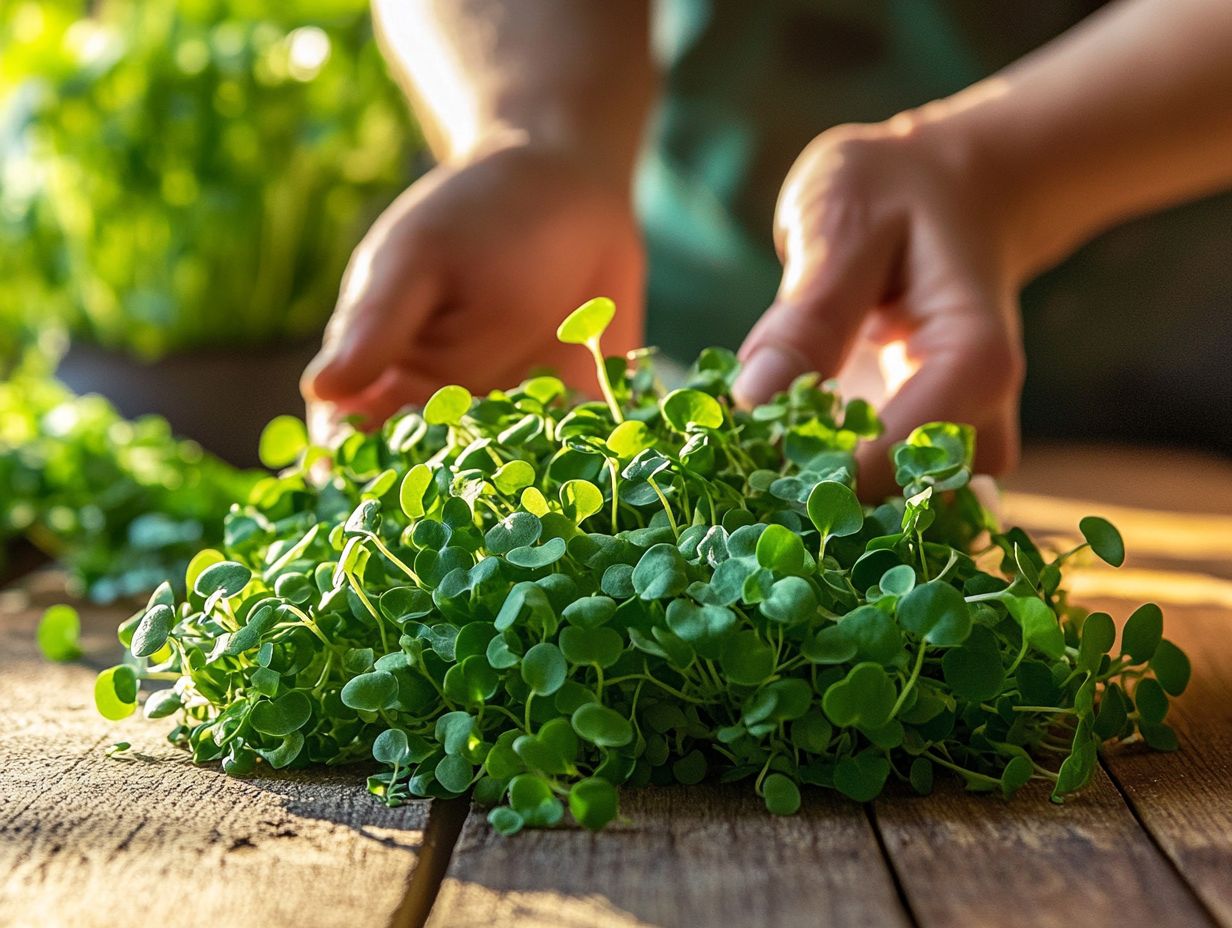
The flavor and texture of microgreens can vary significantly depending on the type you choose. For instance, arugula delivers a delightful peppery taste, while basil brings a sweet, aromatic profile that can elevate your dishes.
Harvesting these vibrant little plants at just the right time is crucial for unlocking their full culinary potential. To achieve the best results, consider understanding microgreen harvest timing. Radish microgreens, known for their crisp texture and zesty kick, add a punch to salads and sandwiches. In contrast, cilantro microgreens provide a refreshing burst of flavor, perfect for garnishing everything from tacos to soups.
But it’s not just about taste; these youthful greens are packed with concentrated vitamins and antioxidants that can enhance your overall health. Incorporating a variety of flavorful microgreens into your meals not only elevates your dining experience but also supports a more nourishing diet.
Best Time of Day to Harvest Microgreens
Harvesting microgreens at the right time can transform their flavor and nutritional value. Many experienced growers recommend early morning or late evening as ideal times, as this is when the plants are most hydrated and full of nutrients.
This careful timing boosts flavor and ensures you collect the microgreens at their most visually striking, making them an exceptional choice for salads and garnishes. Don t miss the chance to maximize their flavor and nutrients!
Timing for Optimal Nutrient Content
Timing is crucial for ensuring that your microgreens maintain optimal nutrient content, especially if you re health-conscious.
When harvested at just the right moment, these young plants deliver a vibrant spectrum of nutrients, from essential vitamins to powerful antioxidants, all designed to enhance your overall wellness. Varieties like sunflower and pea shoots shine when picked between 7 to 14 days after germination, boasting impressive levels of vitamins A, C, and E. Understanding the role of light duration for microgreens can further optimize their growth and nutrient content.
However, delaying the harvest risks diminishing those health benefits and turning delicate flavors into something far less appealing. This affects everything, from the crispness of radish greens to the sweetness of beet microgreens.
Understanding this relationship encourages you to monitor your microgreens closely, ensuring you enjoy both abundant nutrition and rich flavor.
Factors to Consider for Specific Crops
When harvesting specific crops of microgreens, consider factors like density and growth stages for optimal results. Each microgreen variety has unique needs that influence both flavor and texture.
For example, basil microgreens flourish when harvested just above the soil line. In contrast, radish microgreens pack more punch when cut slightly above the first leaves that grow after germination. Understanding timing your microgreens is essential as planting density matters too; shallowly planted varieties can be spaced closely, creating a vibrant carpet of greens, while those needing more sunlight will require greater spacing.
Mastering these considerations refines your growing techniques, resulting in an exquisite final product that showcases the unique qualities of each crop.
Harvesting Techniques for Microgreens
Effective harvesting techniques are crucial for preserving the quality and freshness of your microgreens, ensuring you maximize your gardening efforts. Use clean scissors to cut the microgreens just above the soil level, minimizing any damage to the plant.
Washing and drying the harvested greens properly is essential for maintaining their flavor and nutritional value. Additionally, ensuring you have the perfect light conditions for microgreens can enhance their growth. By mastering these techniques, you can savor your microgreens at their peak freshness while reaping the full spectrum of their health benefits.
Proper Tools and Methods
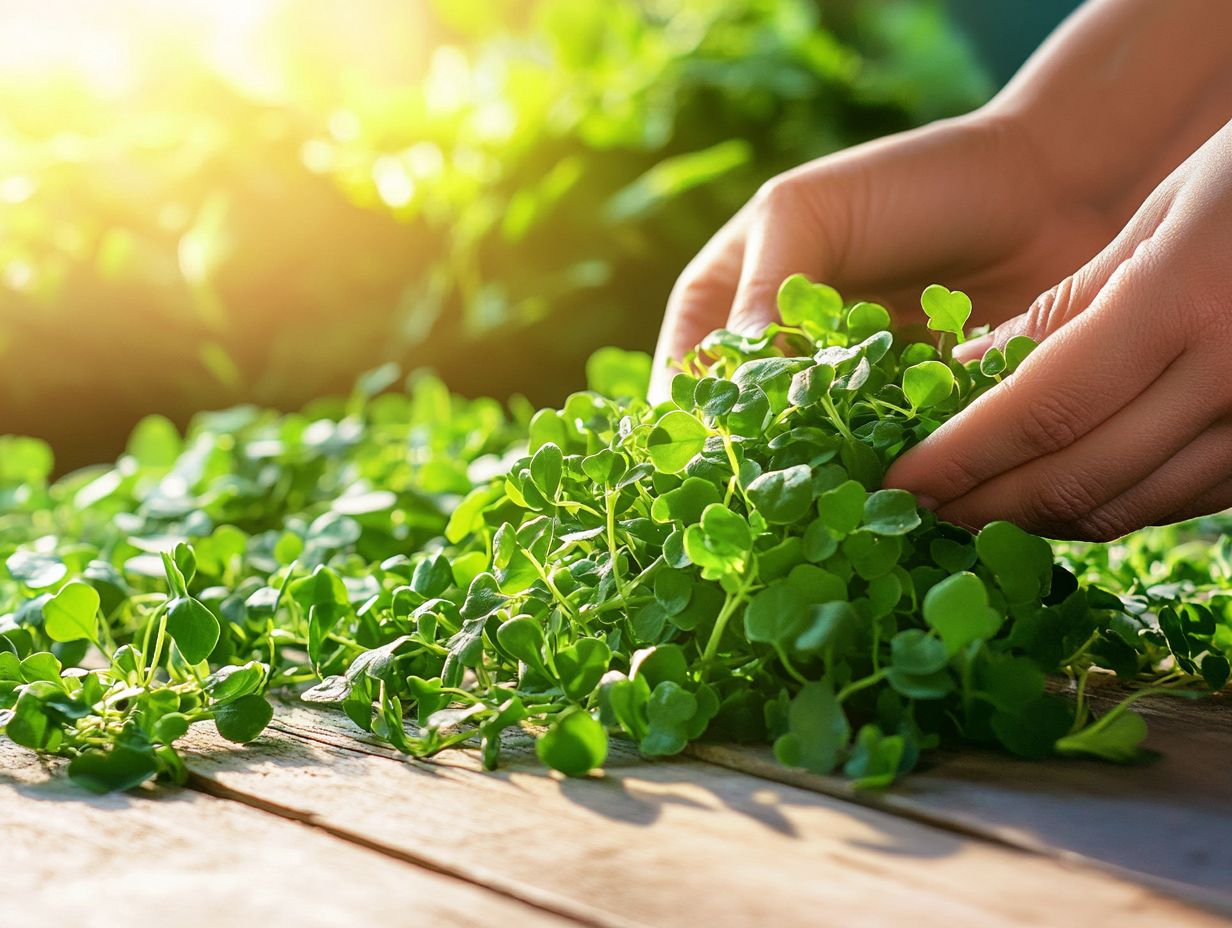
Using the right tools and methods for harvesting microgreens is key to maintaining their quality and health benefits.
A sharp pair of scissors is essential for a clean cut. This encourages faster regrowth and protects those delicate stems.
Keep a small basket or container nearby to collect the freshly cut greens. This prevents bruising and keeps them in great shape.
After harvesting, wash the microgreens gently under cool running water. This removes soil residue and keeps them crisp and appealing.
Once washed, pat them dry with a kitchen towel or use a salad spinner to remove moisture. This step helps avoid spoilage.
Store the microgreens in breathable containers to extend their shelf life. This way, you can enjoy their delightful flavors and nutrients in various dishes.
Storing and Using Harvested Microgreens
Proper storage and usage of harvested microgreens can enhance your culinary experience. You’ll appreciate their vibrant flavors and health benefits.
After washing and drying them, store microgreens in a cool, dark place or refrigerator. This helps preserve their freshness and prevents spoilage.
Incorporate them into salads or as toppings to boost the flavor and nutritional value of your meals.
By mastering these storage techniques, you can continue to enjoy your microgreens long after the harvest.
Proper Storage and Ways to Incorporate into Meals
Store microgreens correctly to maintain their flavor and nutritional value. This allows you to incorporate them into various meals.
Use breathable containers that promote air circulation and maintain humidity. Keep the temperature around 40 F for maximum freshness.
The culinary uses for these healthy greens are endless. Add them to gourmet omelets for an elevated breakfast.
Blend them into a vibrant pesto for pasta dishes, or toss them into a refreshing fruit salad for a peppery twist that excites your taste buds.
Frequently Asked Questions
What is the best time of day to harvest microgreens?
Harvest microgreens in the morning for the freshest and most flavorful greens.
Can microgreens be harvested at any time of day?
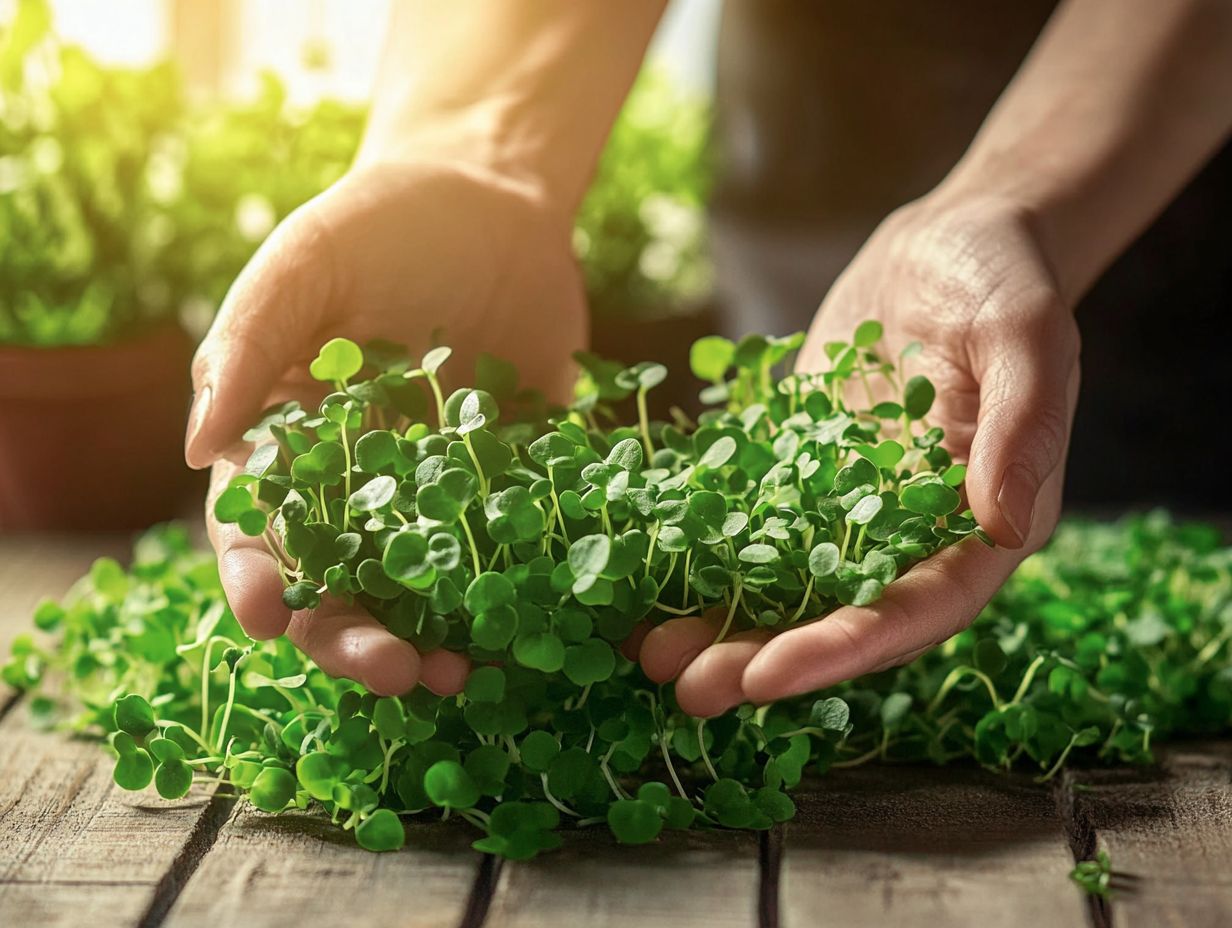
While you can harvest microgreens any time, mornings are ideal. The heat of the sun can cause the greens to wilt and lose flavor.
Why is it important to harvest microgreens at the right time of day?
Harvesting at the right time ensures peak flavor and nutrition. It also preserves their delicate texture and appearance.
Are there certain factors to consider when determining the best time of day to harvest microgreens?
Yes, consider the type of microgreen, growing conditions, and your preference when determining harvest time.
Can microgreens be harvested in the evening?
While possible, evening harvesting isn’t recommended. The greens may be less flavorful and could wilt from the day’s heat.
Do different types of microgreens have different optimal harvest times?
Yes, different types may have different optimal times. Some are best harvested in the morning while others thrive in the afternoon. Research your specific microgreen for the best results.

